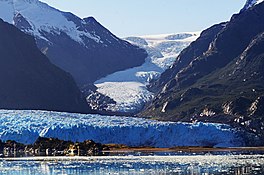Amalia Glacier
In today's world, Amalia Glacier is a topic that has captured the attention and interest of people from all walks of life. From its impact on society to its relevance in politics and economics, Amalia Glacier has proven to be a multifaceted topic that deserves to be explored in depth. As we continue to move forward in the digital age, Amalia Glacier continues to be relevant and current, raising questions and challenges that deserve to be addressed seriously and thoughtfully. In this article, we will explore different aspects of Amalia Glacier, from its origin to its impact on our daily lives, with the aim of shedding light on a topic that is constantly evolving.
| Amalia Glacier | |
|---|---|
| Skua Glacier | |
 Amalia Glacier in 2019 | |
| Type | Tidewater glacier |
| Location | Chile |
| Coordinates | 50°55′S 73°37′W / 50.917°S 73.617°W |
| Area | 158 km2 (61 sq mi) |
| Length | 21 km (13 mi) |
| Status | Retreating |
Amalia Glacier, also known as Skua Glacier, is a tidewater glacier located in Bernardo O'Higgins National Park on the edge of the Sarmiento Channel. The glacier originates in the Southern Patagonian Ice Field. From 1945 to 1986, its terminus retreated 7 km (4.3 mi), being, along with the recession of the O'Higgins Glacier, the most dramatic retreat of the glaciers of the mentioned icefield during that period.
The glacier partially surrounds Reclus volcano and erodes the northern flank of it.
See also
References
- ^ a b Southern Patagonia Icefield (Campo de Hielo Sur) Archived 2012-03-24 at the Wayback Machine, www.glaciologia.cl
- ^ USGS. "P 1386-I Chile and Argentina - Wet Andes:History". Archived from the original on 15 October 2008. Retrieved 2008-10-09.
External links
 Media related to Amalia Glacier at Wikimedia Commons
Media related to Amalia Glacier at Wikimedia Commons
